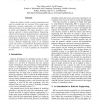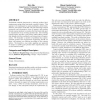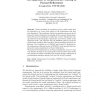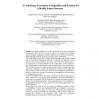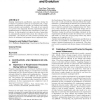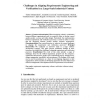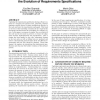116
Voted
EKNOW
2009
14 years 10 months ago
2009
Modeling is a complex and central activity in many domains. Domain experts and designers usually work by drawing and create models from the middle-out; however, visual and middle-...
126
click to vote
ASWEC
2009
IEEE
14 years 10 months ago
2009
IEEE
Failure of a design to satisfy a system's requirements can result in schedule and cost overruns. When using current approaches, ensuring requirements are satisfied is often d...
141
Voted
AOSD
2009
ACM
14 years 10 months ago
2009
ACM
Traditional methods characterize a software product line's requirements using either functional or quality criteria. This appears to be inadequate to assess modularity, detec...
92
Voted
VSTTE
2010
Springer
14 years 10 months ago
2010
Springer
Formal modeling of computing systems yields models that are intended to be correct with respect to the requirements that have been formalized. The complexity of typical computing s...
120
click to vote
TRIDENTCOM
2010
IEEE
14 years 10 months ago
2010
IEEE
The Internet enables the way how global businesses and communities communicate today. In the last years, however, new demands have collided with old designs, resulting in a complex...
103
Voted
SIGSOFT
2010
ACM
14 years 10 months ago
2010
ACM
Keeping requirements specification up-to-date during the evolution of a software system is an expensive task. Consequently, specifications are usually not updated and rapidly beco...
173
Voted
REFSQ
2010
Springer
2010
Springer
Challenges in Aligning Requirements Engineering and Verification in a Large-Scale Industrial Context
14 years 10 months ago
[Context and motivation] When developing software, coordination between different organizational units is essential in order to develop a good quality product, on time and within b...
109
click to vote
RCIS
2010
14 years 10 months ago
2010
Continuous customer-centric requirements reprioritization is essential in successfully performing agile software development. Yet, in the agile RE literature, very little is known ...
104
click to vote
IWPSE
2010
IEEE
14 years 10 months ago
2010
IEEE
Updating the requirements specification during software evolution is a manual and expensive task. Therefore, software engineers usually choose to apply modifications directly to t...
117
Voted
SPLC
2010
14 years 11 months ago
2010
Product line engineering allows for the rapid development of variants of a domain specific application by using a common set of reusable assets often known as core assets. Variabil...

